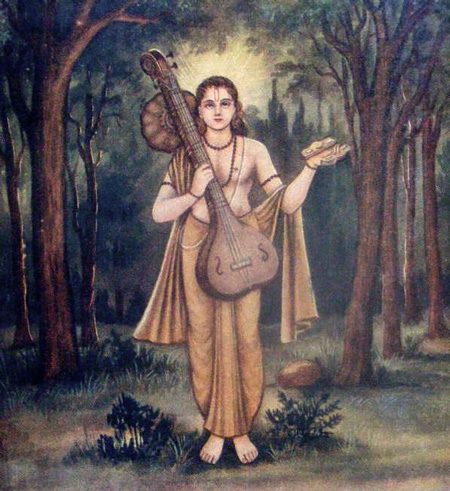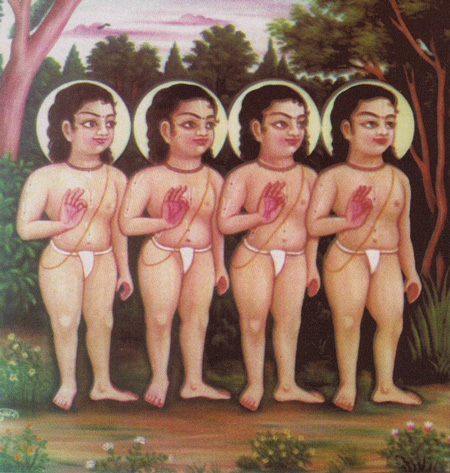
The tale of Sanatkumara and Narada from the Chhandogya Upanishad unfolds like a luminous thread, entwined with profound questions about life and knowledge. Narada, a renowned sage revered for his vast learning and mystical powers, finds himself consumed by an unyielding thirst for something deeper, an escape from the unending cycle of sorrow and dissatisfaction. Driven by this yearning, he seeks the guidance of Sanatkumara, a radiant youth embodying eternal wisdom.
Narada, a great sage, was eager to attain the highest knowledge and approached Sanatkumara, a wise and learned sage, for guidance. Sanatkumara instructed Narada to meditate on the nature of the self and to develop devotion to the ultimate reality.

Narada approaches Sanatkumara burdened by his immense knowledge. He boasts of mastering the four Vedas, the epics, and innumerable other disciplines. Yet, he confesses his heart remains heavy, yearning for true liberation. This paradox forms the heart of the dialogue - the insufficiency of mere erudition in attaining real knowledge, the void beyond worldly accomplishments.
Sanatkumara, with his unwavering compassion, patiently engages Narada in a philosophical exploration. He begins by asking about the extent of his knowledge, not to belittle, but to expose the limitations inherent in worldly learning. Like peeling away layers of an onion, Sanatkumara reveals how each layer of knowledge, from the Vedas to grammar and logic, offers only temporary satisfaction and control, failing to quench the thirst for lasting peace.

The dialogue then ascends to higher planes of understanding. Sanatkumara introduces concepts like "Speech," "Mind," "Will," and "Meditation," each transcending the previous in its breadth and depth. He emphasizes that true knowledge lies not in acquiring more information, but in expanding our consciousness, in silencing the incessant noise of the mind and reaching the stillness of the Self.
The climax of the dialogue arrives when Sanatkumara introduces the concept of "Satya," the ultimate truth, the eternal Self. This truth, he explains, cannot be grasped through language or concepts, for it lies beyond the realm of names and forms. It is the essence of all beings, the unmoving ground beneath the ever-changing world.
Narada followed Sanatkumara's instructions and practiced meditation and devotion with great dedication. However, despite his efforts, he could not attain the ultimate truth.
Sanatkumara then revealed to Narada that true knowledge cannot be acquired through mere study or practice, but only through direct experience and realization. He taught Narada the ultimate truth that the self is not different from the ultimate reality, but one and the same.
Narada, his intellect illuminated and ego humbled, finally understands the nature of his quest. He realizes that true knowledge is not an acquisition, but a rediscovery of the Self that already exists within. This revelation becomes the fire that transforms him, guiding him on the path of liberation.
He became enlightened and realized the ultimate truth. He was filled with immense joy and gratitude and praised Sanatkumara for his guidance and wisdom.
The story of Sanatkumara and Narada is not merely a recounting of ancient wisdom. It resonates with profound meaning for us even today. It reminds us that:
True knowledge is not found in external sources, but in the depths of our own being.
Intellectual pursuits, while valuable, can only take us so far. It is through inner self-exploration and meditation that we reach the essence of existence.
The ultimate reality cannot be grasped by the mind, but can be experienced through silence and surrender.
The journey of self-discovery is an ongoing process, a continuous peeling away of layers to reach the luminous core within.
The tale of Sanatkumara and Narada serves as a timeless invitation to embark on our own inner journey, to move beyond the limitations of the mind and seek the eternal light that resides within each of us. It is a call to rediscover ourselves, not as collections of knowledge or achievements, but as sparks of the infinite, forever connected to the source of all being.
So, let this story ignite a spark within you, to embark on your own quest for self-realization, remembering that the ultimate destination is not a place, but a state of being - a being of peace, of wholeness, of oneness with the eternal Self.
Try out the other sections